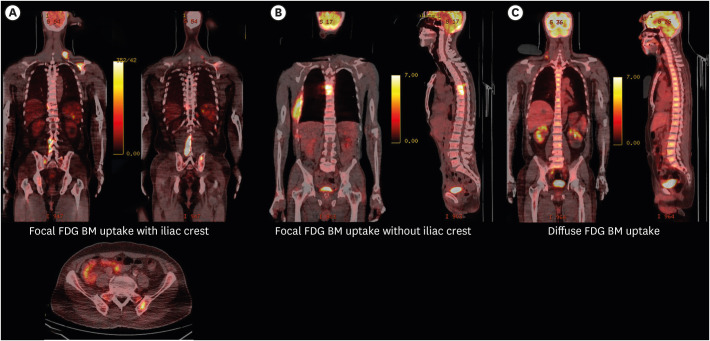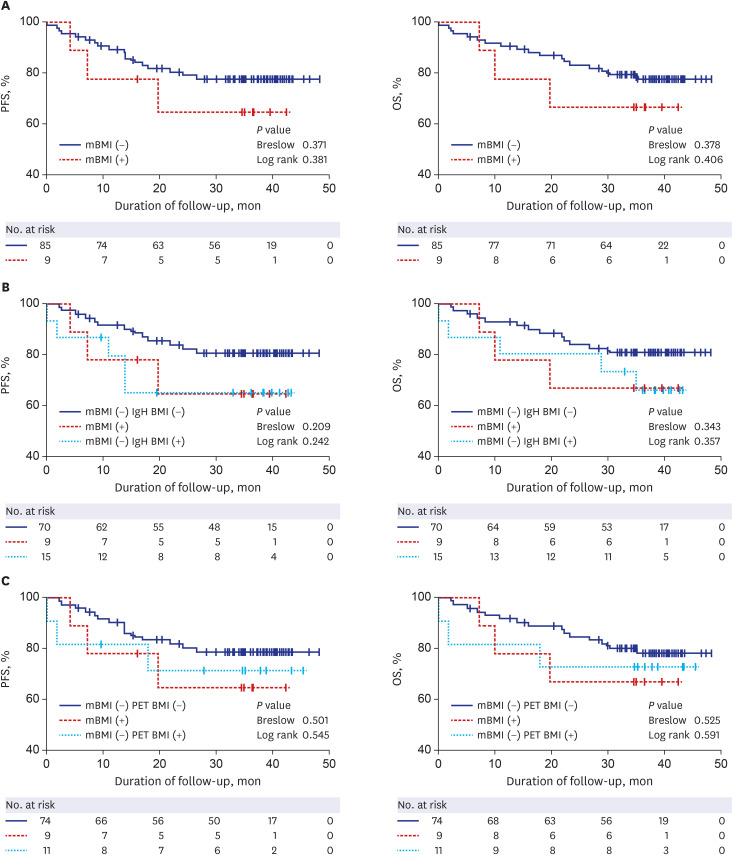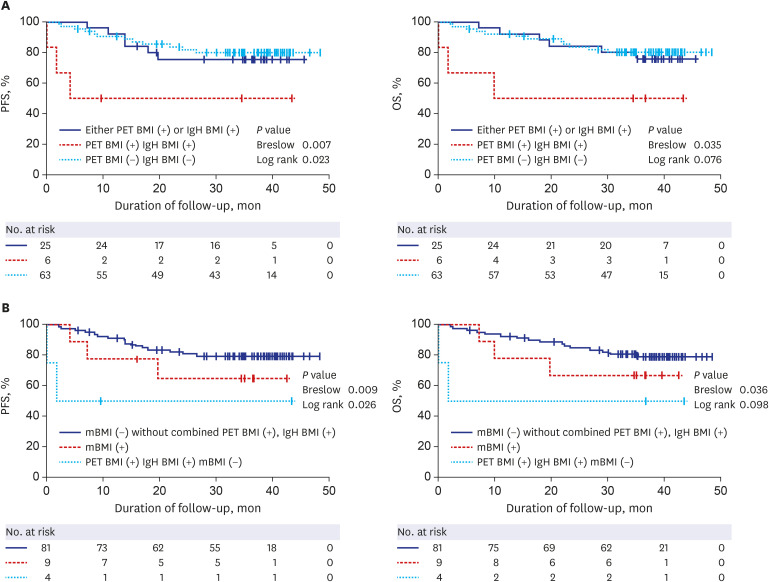J Korean Med Sci.
2022 Jan;37(1):e2. 10.3346/jkms.2022.37.e2.
Diagnostic Accuracy and Prognostic Relevance of Immunoglobulin Heavy Chain Rearrangement and 18F-FDGPET/CT Compared With Unilateral Bone Marrow Trephination for Detecting Bone Marrow Involvement in Patients With Diffuse Large B-Cell Lymphoma
- Affiliations
-
- 1Department of Hematology-Oncology, Chonnam National University Hwasun Hospital, Chonnam National University Medical School, Hwasun, Korea
- 2Department of Laboratory Medicine, Chonnam National University Hwasun Hospital, Chonnam National University Medical School, Hwasun, Korea
- 3Department of Thoracic and Cardiovascular Surgery, Chonnam National University Hwasun Hospital, Chonnam National University Medical School, Hwasun, Korea
- KMID: 2524180
- DOI: http://doi.org/10.3346/jkms.2022.37.e2
Abstract
- Background
In diffuse large B-cell lymphoma (DLBCL), bone marrow involvement (BMI) has an important clinical implication as a component of staging and International Prognostic Index. This study aimed to determine whether molecular analysis of immunoglobulin heavy chain (IgH) genes and positron emission tomography-computed tomography (PET/CT) could overcome the limitation of defining morphologic BMI by trephination biopsy and could increase the diagnostic accuracy or prognostic prediction.
Methods
A total of 94 de novo patients with DLBCL underwent PET/CT, polymerase chain reaction (PCR) test for detection of IgH gene rearrangement, and unilateral bone marrow (BM) trephination at diagnosis.
Results
A total of 9 patients (9.6%) were confirmed to present morphologic BMI (mBMI) based on trephination biopsy. On the other hand, 21 patients (22.3%) were confirmed to have IgH clonality (IgH BMI), while 16 (17.0%) were classified with BMI based on the assessment of PET/CT (PET BMI). Each IgH rearrangement PCR and PET/CT showed the high negative predictive value of detecting the BMI. However, the combined assessment of IgH rearrangement and PET/CT could increase the diagnostic accuracy and specificity with 87.2% and 97.0%, respectively. The survival outcome of patients with double positive PET BMI and IgH BMI was significantly worse than that with either single positive PET BMI or IgH BMI, and even less than patients with neither PET BMI nor IgH BMI (3-year PFS: 50.0% vs. 75.4% vs. 97.9%, P = 0.007, 3-year OS: 50.0% vs. 75.6% vs. 80.1%, P = 0.035, respectively).
Conclusion
This study suggests that the combined evaluation of PET/CT and IgH rearrangement could give additional information for predicting therapeutic outcomes in patients with negative morphologic BMI as an important part of the prognosis.
Figure
Reference
-
1. International Non-Hodgkin’s Lymphoma Prognostic Factors Project. A predictive model for aggressive non-Hodgkin’s lymphoma. N Engl J Med. 1993; 329(14):987–994. PMID: 8141877.2. Park Y, Park BB, Jeong JY, Kim WY, Jang S, Shin BK, et al. Assessment of bone marrow involvement in patients with lymphoma: report on a consensus meeting of the Korean Society of Hematology Lymphoma Working Party. Korean J Intern Med. 2016; 31(6):1030–1041. PMID: 27809449.
Article3. Arber DA, George TI. Bone marrow biopsy involvement by non-Hodgkin’s lymphoma: frequency of lymphoma types, patterns, blood involvement, and discordance with other sites in 450 specimens. Am J Surg Pathol. 2005; 29(12):1549–1557. PMID: 16327427.4. Lee WI, Lee JH, Kim IS, Lee KN, Kim SH. Bone marrow involvement by non-Hodgkin’s lymphom. J Korean Med Sci. 1994; 9(5):402–408. PMID: 7702789.
Article5. Yao Z, Deng L, Xu-Monette ZY, Manyam GC, Jain P, Tzankov A, et al. Concordant bone marrow involvement of diffuse large B-cell lymphoma represents a distinct clinical and biological entity in the era of immunotherapy. Leukemia. 2018; 32(2):353–363. PMID: 28745330.
Article6. Jung SY, Jung SH, Ahn SY, Lee JJ, Kim HJ, Lee JH, et al. Diagnostic accuracy of immunoglobulin heavy chain rearrangement, FDG-PET/CT and unilateral bone marrow trephination for detecting bone marrow involvement in diffuse large B cell lymphoma. Blood. 2018; 132(Suppl 1):4236.
Article7. Isasi CR, Lu P, Blaufox MD. A metaanalysis of 18F-2-deoxy-2-fluoro-D-glucose positron emission tomography in the staging and restaging of patients with lymphoma. Cancer. 2005; 104(5):1066–1074. PMID: 16047335.8. Avigdor A. Staging DLBCL: bone marrow biopsy or PET-CT? Blood. 2013; 122(1):4–5. PMID: 23828884.
Article9. Khan AB, Barrington SF, Mikhaeel NG, Hunt AA, Cameron L, Morris T, et al. PET-CT staging of DLBCL accurately identifies and provides new insight into the clinical significance of bone marrow involvement. Blood. 2013; 122(1):61–67. PMID: 23660958.
Article10. Shah HJ, Keraliya AR, Jagannathan JP, Tirumani SH, Lele VR, DiPiro PJ. Diffuse large B-cell lymphoma in the era of precision oncology: how imaging is helpful. Korean J Radiol. 2017; 18(1):54–70. PMID: 28096718.
Article11. Aide N, Talbot M, Fruchart C, Damaj G, Lasnon C. Diagnostic and prognostic value of baseline FDG PET/CT skeletal textural features in diffuse large B cell lymphoma. Eur J Nucl Med Mol Imaging. 2018; 45(5):699–711. PMID: 29214417.
Article12. Hutchings M, Loft A, Hansen M, Pedersen LM, Berthelsen AK, Keiding S, et al. Position emission tomography with or without computed tomography in the primary staging of Hodgkin’s lymphoma. Haematologica. 2006; 91(4):482–489. PMID: 16585015.13. Ghielmini M, Vitolo U, Kimby E, Montoto S, Walewski J, Pfreundschuh M, et al. ESMO Guidelines consensus conference on malignant lymphoma 2011 part 1: diffuse large B-cell lymphoma (DLBCL), follicular lymphoma (FL) and chronic lymphocytic leukemia (CLL). Ann Oncol. 2013; 24(3):561–576. PMID: 23175624.
Article14. Song MK, Yang DH, Lee GW, Lim SN, Shin S, Pak KJ, et al. High total metabolic tumor volume in PET/CT predicts worse prognosis in diffuse large B cell lymphoma patients with bone marrow involvement in rituximab era. Leuk Res. 2016; 42:1–6. PMID: 26851438.
Article15. Yang DH, Ahn JS, Byun BH, Min JJ, Kweon SS, Chae YS, et al. Interim PET/CT-based prognostic model for the treatment of diffuse large B cell lymphoma in the post-rituximab era. Ann Hematol. 2013; 92(4):471–479. PMID: 23238895.
Article16. Baek DW, Cho HJ, Kim JH, Sohn SK, Song GY, Ahn SY, et al. Quantitative assessment of interim PET/CT could have more prognostic relevance than visual assessment for predicting clinical outcome of extranodal diffuse large B cell lymphoma. In Vivo. 2020; 34(4):2127–2134. PMID: 32606193.
Article17. Hoeve MA, Krol AD, Philippo K, Derksen PW, Veenendaal RA, Schuuring E, et al. Limitations of clonality analysis of B cell proliferations using CDR3 polymerase chain reaction. Mol Pathol. 2000; 53(4):194–200. PMID: 11040942.
Article18. Kokovic I, Novakovic BJ, Cerkovnik P, Novakovic S. Clonality analysis of lymphoid proliferations using the BIOMED-2 clonality assays: a single institution experience. Radiol Oncol. 2014; 48(2):155–162. PMID: 24991205.
Article19. Arnold A, Cossman J, Bakhshi A, Jaffe ES, Waldmann TA, Korsmeyer SJ. Immunoglobulin-gene rearrangements as unique clonal markers in human lymphoid neoplasms. N Engl J Med. 1983; 309(26):1593–1599. PMID: 6417538.
Article20. Park CK, Kim CW, Kim IS, Lee JD. Immunoglobulin and T-cell receptor gene rearrangement analysis in malignant lymphoid neoplasms. J Korean Med Sci. 1994; 9(5):362–368. PMID: 7702783.
Article21. Stevenson F, Sahota S, Zhu D, Ottensmeier C, Chapman C, Oscier D, et al. Insight into the origin and clonal history of B-cell tumors as revealed by analysis of immunoglobulin variable region genes. Immunol Rev. 1998; 162(1):247–259. PMID: 9602369.
Article22. Nam AS, Ma J, Miyaguchi A, Redmond D, Nie K, Elemento O, et al. Exploring the tumor clonal dynamics between diffuse large B-cell lymphomas and bone marrow involvement by deep immunoglobulin heavy chain VDJ sequencing. Blood. 2017; 130(Suppl 1):2737.23. Evans PA, Pott C, Groenen PJ, Salles G, Davi F, Berger F, et al. Significantly improved PCR-based clonality testing in B-cell malignancies by use of multiple immunoglobulin gene targets. Report of the BIOMED-2 Concerted Action BHM4-CT98-3936. Leukemia. 2007; 21(2):207–214. PMID: 17170731.
Article24. Mitterbauer-Hohendanner G, Mannhalter C, Winkler K, Mitterbauer M, Skrabs C, Chott A, et al. Prognostic significance of molecular staging by PCR-amplification of immunoglobulin gene rearrangements in diffuse large B-cell lymphoma (DLBCL). Leukemia. 2004; 18(6):1102–1107. PMID: 15085149.
Article25. Cho SR, Park IJ, Lee MS, Kim EK, Lee WG, Han JH, et al. Polymerase chain reaction and sequencing of immunoglobulin heavy chain gene rearrangement in formalin fixed, paraffin-embedded tissue of patients with B cell lymphoma. kjh. 2007; 42(4):361.
Article26. Seo JY, Hong J, Chun K, Jeong J, Cho H, Kim KH, et al. Prognostic significance of PCR-based molecular staging in patients with diffuse large B-cell lymphoma treated with R-CHOP immunochemotherapy. Leuk Lymphoma. 2017; 58(2):357–365. PMID: 27282995.
Article27. Green TM, Jensen AK, Holst R, Falgreen S, Bøgsted M, de Stricker K, et al. Multiplex polymerase chain reaction-based prognostic models in diffuse large B-cell lymphoma patients treated with R-CHOP. Br J Haematol. 2016; 174(6):876–886. PMID: 27196819.
Article28. Kim JH, Lee JY, Son JA, Song SA, Oh SH, Shin JH, et al. Clinical significance of clonal rearrangement of the immunoglobulin gene in the bone marrow of patients with B-cell non-hodgkin lymphoma. Lab Med Online. 2014; 4(3):125.
Article29. Sung JY, Kang SY, Kim SH, Kwon JE, Ko YH. Analysis of immunoglobulin gene rearrangement: comparison between BIOMED-2 multiplex PCR and conventional nested PCR. Lab Med Online. 2011; 1(4):195–201.
Article30. Yoo KH, Lee H, Suh C; CISL. Lymphoma epidemiology in Korea and the real clinical field including the Consortium for Improving Survival of Lymphoma (CISL) trial. Int J Hematol. 2018; 107(4):395–404. PMID: 29357080.
Article31. Chen Y, Zhou M, Liu J, Huang G. Prognostic value of bone marrow FDG uptake pattern of PET/CT in newly diagnosed diffuse large B-cell lymphoma. J Cancer. 2018; 9(7):1231–1238. PMID: 29675104.
Article32. Adams HJ, Kwee TC, de Keizer B, Fijnheer R, de Klerk JM, Nievelstein RA. FDG PET/CT for the detection of bone marrow involvement in diffuse large B-cell lymphoma: systematic review and meta-analysis. Eur J Nucl Med Mol Imaging. 2014; 41(3):565–574. PMID: 24281821.
Article33. Berthet L, Cochet A, Kanoun S, Berriolo-Riedinger A, Humbert O, Toubeau M, et al. In newly diagnosed diffuse large B-cell lymphoma, determination of bone marrow involvement with 18F-FDG PET/CT provides better diagnostic performance and prognostic stratification than does biopsy. J Nucl Med. 2013; 54(8):1244–1250. PMID: 23674577.
Article34. Hantaweepant C, Chinthammitr Y, Khuhapinant A, Sukpanichnant S. Clinical significance of bone marrow involvement as confirmed by bone marrow aspiration vs. bone marrow biopsy in diffuse large B-cell lymphoma. J Med Assoc Thai. 2016; 99(3):262–269. PMID: 27276736.35. Yi HG, Kim JS, Suh C, Kim WS, Kwak JY, Lee JS, et al. Clinical features and survival outcomes of patients with diffuse large B-cell lymphoma: analysis of web-based data from the Korean Lymphoma Working Party Registry. Blood Res. 2013; 48(2):115–120. PMID: 23826580.
Article36. Burton C, Ell P, Linch D. The role of PET imaging in lymphoma. Br J Haematol. 2004; 126(6):772–784. PMID: 15352980.
Article37. Shim H, Oh JI, Park SH, Jang S, Park CJ, Huh J, et al. Prognostic impact of concordant and discordant cytomorphology of bone marrow involvement in patients with diffuse, large, B-cell lymphoma treated with R-CHOP. J Clin Pathol. 2013; 66(5):420–425. PMID: 23610041.
Article38. Sehn LH, Scott DW, Chhanabhai M, Berry B, Ruskova A, Berkahn L, et al. Impact of concordant and discordant bone marrow involvement on outcome in diffuse large B-cell lymphoma treated with R-CHOP. J Clin Oncol. 2011; 29(11):1452–1457. PMID: 21383296.
Article39. Alonso-Álvarez S, Alcoceba M, García-Álvarez M, Blanco O, Rodríguez M, Baile M, et al. Biological features and prognostic impact of bone marrow infiltration in patients with diffuse large B-cell lymphoma. Cancers (Basel). 2020; 12(2):E474. PMID: 32085520.
Article40. Talaulikar D, Dahlstrom JE, Shadbolt B, McNiven M, Broomfield A, Pidcock M. Occult bone marrow involvement in patients with diffuse large B-cell lymphoma: results of a pilot study. Pathology. 2007; 39(6):580–585. PMID: 18027262.
Article41. Arima H, Maruoka H, Nasu K, Tabata S, Kurata M, Matsushita A, et al. Impact of occult bone marrow involvement on the outcome of rituximab plus cyclophosphamide, doxorubicin, vincristine and prednisone therapy for diffuse large B-cell lymphoma. Leuk Lymphoma. 2013; 54(12):2645–2653. PMID: 23566159.
Article
- Full Text Links
- Actions
-
Cited
- CITED
-
- Close
- Share
- Similar articles
-
- Diffuse Bone Marrow Uptake of 99mTc-MIBI in A Case of Intravascular Large B-cell Lymphoma
- Effects of Increased Lymphocytes and B Cell Clonality of Marrow Aspirates on Marrow Involvement and Prognosis in Children with Neuroblastoma
- Clinical Significance of Clonal Rearrangement of the Immunoglobulin Gene in the Bone Marrow of Patients with B-cell Non-Hodgkin Lymphoma
- Usefulness of 18F-FDG PET/CT for the Evaluation of Bone Marrow Involvement in Patients with High-Grade Non-Hodgkin's Lymphoma
- Utility of an immunoglobulin gene rearrangement assay based on multiplex PCR in detecting bone marrow involvement in B-cell non-Hodgkin lymphoma




